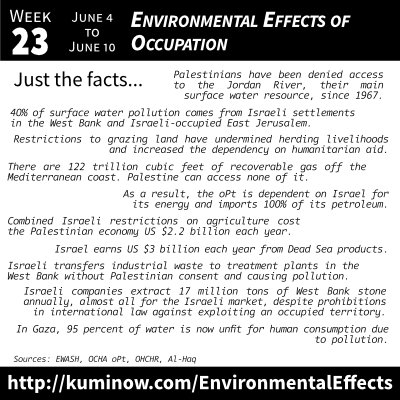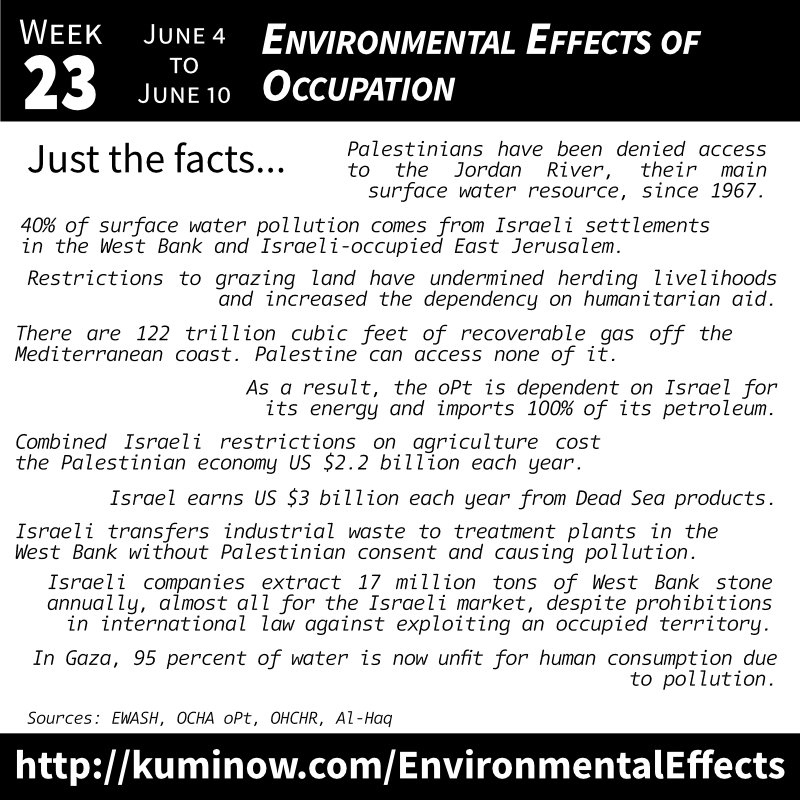Just the Facts: Environmental Effects of Occupation


- Palestinians have been denied access to the Jordan River, their main surface water resource, since 1967.
- 40% of surface water pollution comes from Israeli settlements in the West Bank Israeli-occupied East Jerusalem, including settlements there.
- 16 Palestinian communities are dependent on springs as their only source of drinking water.
- Access restrictions to grazing land have undermined herding and agricultural livelihoods and increased the dependency on humanitarian assistance.
- 30% of drinking water in Gaza is lost through network leaks.
- Israeli quarry companies extract 17 million tons of West Bank stone annually, almost all for the Israeli market, despite prohibitions in international law against exploiting an occupied territory.
- The transfer of Israeli industrial waste to treatment plants in the West Bank, without Palestinian consent, contributes to the environmental scarring of the occupied territory.
- In Gaza, the collapse of the coastal aquifer is contributing to a significant health crisis among two million Palestinians.
- There are 122 trillion cubic feet of recoverable gas off the Mediterranean coast of Gaza, Israel and Lebanon. Palestine can access none of it.
- As a result, the oPt is almost completely dependent on Israel for its energy and imports 100% of its petroleum.
- Israel earns $3 billion each year from Dead Sea products, and its 15 hotels on the shore generate around $291 million.
- Israel’s national water company, Mekorot, routinely cuts the water supply to Palestinians — sometimes by as much as 50 percent — during the summer months in order to meet demand in the settlements.
- In Gaza, 95 percent of water is now unfit for human consumption due to pollution.
- Combined Israeli restrictions on agriculture cost the Palestinian economy $2.2 billion each year.
- The World Bank estimates that Palestine would boost its economy by $3.4 billion if it was able to exploit its own resources.
- West Bank Palestinians each consume 107-156 cubic meters of water per year; a Jewish settler uses 650-1,714 cubic meters per year.
This week’s Just the Facts comes from:
- “EWASH Advocacy Task Force: Water resources in the West Bank”
- “Occupied Palestinian Territory: Humanitarian Facts and Figures” from OCHA oPt
- “Report of the Special Rapporteur on the situation of human rights in the Palestinian territories occupied since 1967” from OCHCR
- “Facts on the Ground: How Natural Resources Fuel the Israeli-Palestinian Conflict” from Al-Haq
- “The Environmental Impact of Jewish Settlements in the West Bank” by Violet Qumsieh for Palestine-Israel Journal
Learning More
You can learn more by reading the article “An Environmental Nakba: The Palestinian Environment Under Israeli Colonization” by Mazin B. Qumsiyeh and Mohammed A. Abusarhan for Science for the People and the report “Environmental Nakba Environmental injustice and violations of the Israeli occupation of Palestine” from Friends of the Earth International.
To go deeper, we are developing an extensive list of Additional Resources at the bottom of this week’s entry as well as a YouTube playlist on the subject.
